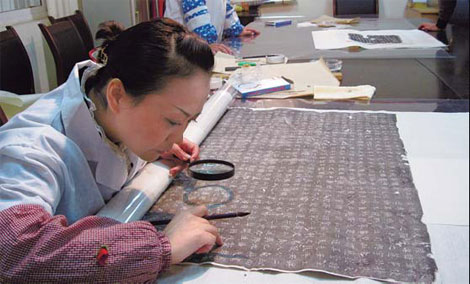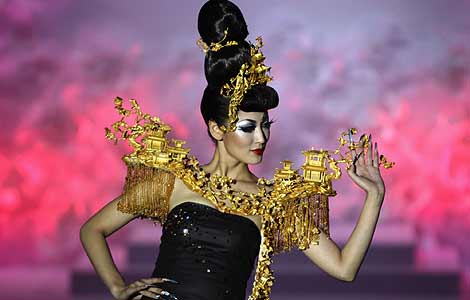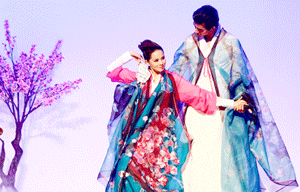Restorers of records
Updated: 2011-10-28 08:06
By Erik Nilsson (China Daily)
|
|||||||||
|
A repair specialist works on an old tapian at the Western Sichuan Literature Repair Center. Provided to China Daily |
The best method to repair ancient books, it turns out, is older than many of the books themselves.
At least that's what workers at the Western Sichuan Literature Repair Center say.
The center in Sichuan province's Guanghan county has been using an 18-step technique passed down from master to apprentice since the Han Dynasty (AD 25-220) to repair 3,700 writings from previous centuries, since it opened in 2008.
"It's primitive and difficult- but, most importantly, it works," the center's director Peng Dequan says.
Worms, moths, wear and tear and decomposition are the foes his 12 workers battle to reincarnate these books so these records of the past can live into the future.
The process' essence is to paste together page tatters with a boiled concoction of flour and traditional Chinese medicine (TCM). Then, experts must precisely replicate the calligraphy of long dead character systems as they originally appeared in the texts.
"Industrial chemicals don't work. Only traditional Chinese medicine does. And doing it all by hand is the best way," Peng says.
Holes are patched with handmade bamboo paper produced the same way as millennia ago. The center specially orders the material for 80 yuan ($12.55) a sheet.
It can take three to five days to reassemble a page that is in shreds.
"The work is so detailed," Peng says.
"The pages must be exactly as they were originally, without anything out of place. Exactly matching the colors of the old and new papers is very difficult. So we dye the new sheets with tea or TCM."
All materials must be natural, or they will destroy the books by upsetting their delicate pH, Peng says, referring to the measure of acidity or alkalinity of an aqueous solution.
To preserve an ideal pH balance of 7, pages are turned with black bamboo tongs - believed to repel worms and moths - rather than with fingers.
Completed books are bound with thread, which Peng explains last longer than other materials.
Most works are from the Qing Dynasty (1368-1644) and have been chewed up by worms and moths, Peng says. Many others were damaged in the "cultural revolution" (1966-76). A large number were unearthed from the nearby Sanxingdui archeological site, which hosted a previously unknown civilization that mysteriously vanished in the 11th century BC.
The Western Sichuan Literature Repair Center is the first of its kind in the region and one of only two in the country, Peng says.
There are about 150 tapian - Han-era scrolls of the rubbings of stone calligraphic inscriptions.
"Often, the paper has outlasted the stone," Peng says.
There are also law books from various dynasties and Jingangjin (The Vajra Prajna Paramita Sutra), a Buddhist text brought from India and translated centuries ago.
Many books the center works on enjoy State-level protection, he says. The center was founded and operates through government support after the authorities passed policies prioritizing the preservation of such ancient texts in 2008.
Acclaimed educator Da Zhitao donated 3,000 rare books, and philanthropist Feng Jiahui gave 100,000 yuan when the center opened.
Still, the workers say their incomes are low.
"This is a labor of love," repair specialist Peng Yan says.
"I don't worry about my salary. I earn spiritual joy instead. To repair damaged books is to mend broken hearts."
His colleague Zhang Daocai, who came to work in the center after retiring from a government-run culture center, agrees.
"It's rewarding to see a pile of tatters reincarnated as an intact page," the 56-year-old says.
About 20,000 repaired books line the shelves of the public Sichuan Harmony Library beneath the workshop area.
Peng Dequan says they will soon all be digitalized and put online for the world to view.
"This mission needs more attention not only from the Chinese people but people from all over the world."
Feng, the donor, puts it this way: "These ancient words provide a spiritual pillar for our modern material knowledge."
Li Yu contributed to the story.












